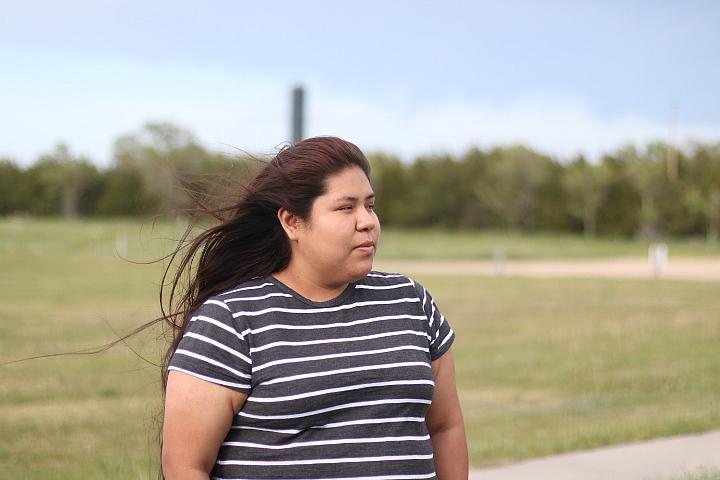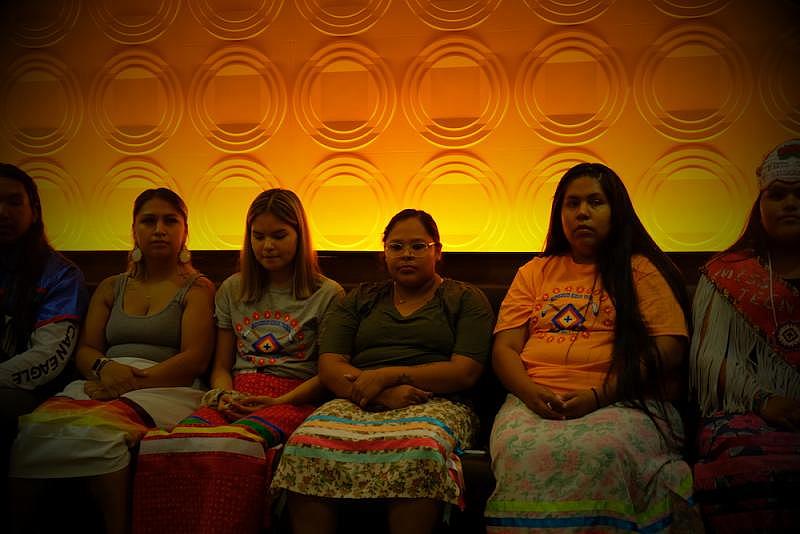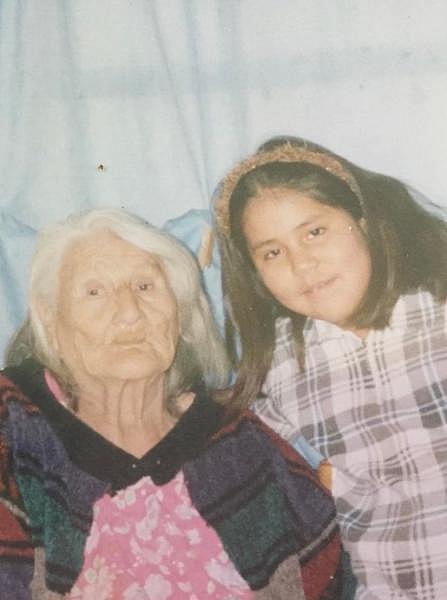How Indian Boarding Schools Have Affected Generations | Part Three: Young Adults Today
This story was produced as a project for the USC Annenberg Center for Health Journalism's 2021 Data Fellowship.
Other stories include:
How Indian Boarding Schools have Impacted Generations | Part One: Survivors
How Indian Boarding Schools have Impacted Generations | Part Two: First Generation Descendants

Rachel Janis, 22, is among the third generation of Indian boarding-school survivors on the Rosebud Indian Reservation helping to reclaim their ancestors’ remains.
(Photo: Jenna Kunze for Native News Online)
This is the third in a three-part series following intergenerational impacts the United States’ nearly 200 year policy of Indian boarding schools had, and continues to have, on some tribal members on the Rosebud Indian Reservation in South Dakota today. This story was produced as a project for the USC Annenberg Center for Health Journalism's 2021 Data Fellowship.
ROSEBUD INDIAN RESERVATION—They were just kids when they learned about the Native children, their ancestors, who never came home from Indian boarding school more than 100 years before.
Seven years ago, a group of Rosebud Sicangu Youth Council members were traveling back from a conference in Washington when the tribal leaders chaperoning them suggested that the group make a side trip to see a bit of their history: the site of the former Carlisle Indian Industrial School, in Carlisle, Pennsylvania.
In 2015, the grounds of the institution—where the U.S. government forcibly assimilated roughly 7,800 Indigenous youth from scores of tribes between 1879 and 1918—still held the remains of about 200 kids who died there of sickness, abuse, and neglect. At least nine of the graves belonged to Rosebud tribal members.
When they returned home to South Dakota, the students had one question for their tribal council: Why are our relatives buried so far from home?
That question spurred a council-backed movement that concluded last summer, with the repatriation of those nine ancestors back home to be reburied on the Rosebud Indian Reservation.
Now, young adults on the Rosebud Indian Reservation continue to lead the efforts to bring home lost ancestors buried at the former boarding schools—all while coming to terms with the ways in which their grandparents’ and great-grandparents’ experiences at those schools affect their lives today.
PICTURED: Janis (orange shirt, second from right) in 2021 at the Carlisle disinterment ceremony in Carlisle, Pennsylvania with members of the Rosebud Sicangu Youth Council. “Healing for me is uncovering trauma, whether you experience it or your parents or your grandparents experienced it,” Rachel Janis said at the time. “When I was younger, I didn’t understand what I was going through. When we first came to Carlisle, although I never experienced boarding schools, I think that was another stem of where that might have come from." (Photo: Jenna Kunze)
An Awakening
In late May, Rachel Janis, 22, sits at her office desk at the Sicangu Youth Council on the Rosebud Indian Reservation. In her hand is a highlighted list of 25 Indian boarding schools in South Dakota—her “life’s work.” She’s surrounded by Native decor, including an “Indians Allowed” sign—the exact opposite message from that of a hotel in Rapid City, South Dakota’s second-largest city, which banned Natives from staying there in March.
Janis was 15 years old during the initial visit to Carlisle Indian School. At the time, she—like her peers—knew very little about boarding schools because her elders rarely talked about their experiences. She didn’t even know that her grandparents had survived boarding schools, or that the collective traumatic experience could be an explanation for some of the problems she observed in her community.
“You know the saying ‘it takes a village to raise a child’? I was raised surrounded by elders,” Janis says, moving her curtain of hair from one shoulder to the other. “But when you’re a child, you don’t think: ‘Something really bad must have happened to her or him for them to act that way.’”
It wasn’t until she was confronted face to face with their history at Carlisle that she began to feel a powerful awakening.
“I didn't know there was more than one [boarding school],” Janis told Native News Online. “When I learned about boarding schools, [I also] learned about historical trauma. It started making sense, how I feel personally.”
Carlisle was just one of over 400 Indian boarding schools operated or funded by the U.S. government from 1819 through 1969, an initial investigation by the Department of the Interior released in April found. Thirty of them were in South Dakota.
That initial report accounted for more than 500 child deaths at just 19 schools. The Interior Department expects further investigation to find that the number of recorded deaths amounted to “thousands or tens of thousands.”
The Sicangu Youth Council is working on an investigation of its own. Janis is now one of five youth members researching the history and records of the boarding schools that operated in South Dakota. Their goal is to search for Rosebud relatives who might have died at any of those institutions, and to continue efforts to bring each child home.
“It’s also about holding the government accountable,” Janis explains. “Because it may have happened in the past, but the after effects are still happening to us today.”
The Hardest Part
Cycle of alcoholism, abuse, and poverty are prevalent in the Rosebud community, and Janis says they were the norm growing up. A 2015 study by the New York-based Center for Court Innovation of ways to prevent children’s exposure to violence in six communities, including Rosebud, found that 90% of adults surveyed on the reservation reported they had witnessed or been directly involved in violence in the previous year. Almost 80% said their children had been exposed to violence in the past year.
When Janis began learning about the history of boarding schools and the spiritual, mental, and physical abuse her people endured, her own experiences started making more sense.
“It wasn't until [my grandparents were] already gone that I learned how deeply boarding schools affected us,” she said, her voice heavy with emotion. She takes a moment, gazing up at the ceiling, to collect herself. “That's when I realized the learned behaviors, the coping, the triggers. I learned when it was too late. I wish that I was able to see their faces and be like, ‘now I know and understand and, for the years that I was so mad at you guys because of how I was raised and how we are, it wasn't your fault.’”
PICTURED: Janis and her late great grandmother, Emma Breast-Zimiga, who was a survivor of St. Francis Mission boarding school on the Rosebud Indian Reservation. (Photo: Courtesy of Rachel Janis)
Trauma is not unique to Indian Country today, says Delores BigFoot (Caddo Nation of Oklahoma), director of the Indian Country Child Trauma Center at the University of Oklahoma Health Sciences Center. But previously, Natives used ceremonies to cope with it, practices that were outlawed by the U.S. government when it occupied Indian land.
BigFoot, a child psychologist whose work focuses on healing trauma, including historical trauma, among Native children and their families, says that disproportionate rates of suicides, violence, and binge-drinking in Native communities don’t happen in isolation, but are related to the cultural cracks caused by colonization.
“We’ve always had trauma,” she says. “There’s always been tsunamis, tornados, conflict, death, but the thing that most tribal communities had that allowed them to have a sense of unity, is an understanding how they fit in the world: It was through ceremony.”
“Ceremony is the protective factor for long-term trauma. With the boarding school, that was one of the things that was disrupted. We don’t have a diagnosis for psychological despair due to colonization. If we could have that kind of diagnosis, maybe we wouldn’t feel like people are reacting in ways that are out of the ordinary to things that have been devastating to their tribal communities.”
As part of her practice, BigFoot trains clinicians in historical trauma and ways to guide the healing process by reintroducing aspects of community, identity, and a sense of belonging to a traumatized child.
Several studies have indicated some promise for using culturally relevant techniques to treat alcohol and drug abuse by American Indians and Alaska Natives.
In one such study, funded by the National Institute of Health in 2011-12, Daniel Dickerson, an Inupiaq clinical psychiatrist at the University of California at Los Angeles, and others ran a pilot program of “drum-assisted recovery therapy”: a three-month program for 10 participants with drug or alcohol dependence that encompassed drum circles and the 12 steps of Alcoholics Anonymous, all within the framework of the Native American Medicine Wheel.
For tribal members like Janis, unpacking her collective history was the medicine she needed to begin breaking the cycle of trauma and abuse in her community and in her own life. She struggled with depression and suicidal ideation as a young adult, and says that reckoning with the roots of her trauma helped her deal with her own grief.
“I was able to realize: ‘Okay, my grandparents went through this, my great-grandma went through this, so it makes sense of how I feel personally,’” Janis says. “I literally feel like there's a heavy black cloud above me. I shouldn’t have to end my life to make it stop. It grows, if you don’t deal with it.”
Instead, Janis has intensified her efforts to heal some of the hurt that affected past generations. In addition to researching former boarding schools, she works for a tribal program that mentors youth on the reservation on leadership and advocacy.
The Resiliency of Our People
Janis is a huge fan of the Marvel superhero movies. That is why when actor and activist Mark Ruffalo, who played the Incredible Hulk in the series, showed up at the Carlisle disinterment ceremony last summer, she was star-struck. She asked for a photo, and told Ruffalo she loved his work.
She recalls that he responded, “I may be a hero on TV, but you are my hero in real life,” referring to the work the Youth Council did to bring home their relatives.
Ruffalo’s compliment bowled her over, but she says the greatest recognition came from elders in her community: “It felt like a full circle to me, because it was the elders who were coming and saying ‘thank you.’ It may not have been my grandparents, but it was someone's grandparents, and that was all I needed: recognition that what we did was okay.”
PICTURED: Janis and her Sicangu Youth Council peers pose with Secretary of the Interior Deb Haaland and actor and activist Mark Ruffalo at Carlisle last year. (Photo: Jenna Kunze)
That feedback motivates Janis to keep going with the work, and to focus on the resiliency of her people, rather than their shortcomings.
“There is pain, there is grief, but there’s also resiliency,” she says. “It was because of those individuals who kept the language [and] the culture while we were at war with the government, that we’re here today.”
“I know change doesn’t happen overnight—it took six years just for nine kids to come home— but I pray that when I’m 40, we have figured out where our children are buried and have brought them home.”
Janis hopes that by the time she reaches 80, the government will have compensated boarding-school survivors, returned the Black Hills to the Lakota people as it promised by treaty, and helped bring home every child who was lost to Indian boarding schools.
“I pray that I get to see cycles be broken, people taking care of the land, and for our children to know: this is what happened in boarding schools, and this is why we feel this way,” she says.
[This article was originally published by Native News Online.]

